Adult Almost Done With Antibiotics and Running Fever Again
Fever is an elevated body temperature. Temperature is considered elevated when information technology is higher than 100.iv° F (38° C) as measured by an oral thermometer or higher than 100.8° F (38.2° C) as measured by a rectal thermometer. Many people utilize the term "fever" loosely, frequently significant that they feel likewise warm, too cold, or sweaty, but they take not actually measured their temperature.
Although 98.vi° F (37° C) is considered normal temperature, trunk temperature varies throughout the mean solar day. Information technology is lowest in the early morning and highest in the tardily afternoon—sometimes reaching 99.9° F (37.7° C). Similarly, a fever does non stay at a constant temperature. Sometimes temperature peaks every day and then returns to normal. This process is called intermittent fever. Alternatively, temperature varies but does not return to normal. This procedure is called remittent fever. Doctors no longer think that the design of the rise and fall of fever is very important in the diagnosis of certain disorders.
The symptoms people have are due mainly to the condition causing the fever rather than the fever itself.
Although many people worry that fever can crusade harm, the typical temporary elevations in body temperature to 100.4° to 104° F (38° to xl° C) caused by most brusk-lived (acute) infections are well-tolerated past healthy adults. Nevertheless, a moderate fever may be slightly dangerous for adults with a heart or lung disorder because fever causes the heart rate and animate rate to increase. Fever can as well worsen mental status in people with dementia.
Infection is not the only cause of fever. Fever may also result from inflammation, a reaction to a drug, an allergic reaction Overview of Allergic Reactions Allergic reactions (hypersensitivity reactions) are inappropriate responses of the immune system to a ordinarily harmless substance. Usually, allergies make people sneeze; the eyes water and itch... read more 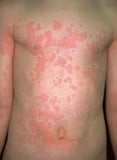 , autoimmune disorders Autoimmune Disorders An autoimmune disorder is a malfunction of the body'due south immune organisation that causes the body to attack its own tissues. What triggers autoimmune disorders is non known. Symptoms vary depending... read more (when the torso produces abnormal antibodies that attack its ain tissues), and undetected cancer (particularly leukemia Overview of Leukemia Leukemias are cancers of white blood cells or of cells that develop into white blood cells. White blood cells develop from stalk cells in the bone marrow. Sometimes the development goes awry... read more , lymphoma Overview of Lymphoma Lymphomas are cancers of lymphocytes, which reside in the lymphatic system and in blood-forming organs. Lymphomas are cancers of a specific type of white blood cells known every bit lymphocytes. These... read more
, autoimmune disorders Autoimmune Disorders An autoimmune disorder is a malfunction of the body'due south immune organisation that causes the body to attack its own tissues. What triggers autoimmune disorders is non known. Symptoms vary depending... read more (when the torso produces abnormal antibodies that attack its ain tissues), and undetected cancer (particularly leukemia Overview of Leukemia Leukemias are cancers of white blood cells or of cells that develop into white blood cells. White blood cells develop from stalk cells in the bone marrow. Sometimes the development goes awry... read more , lymphoma Overview of Lymphoma Lymphomas are cancers of lymphocytes, which reside in the lymphatic system and in blood-forming organs. Lymphomas are cancers of a specific type of white blood cells known every bit lymphocytes. These... read more 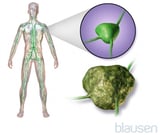 , or kidney cancer Kidney Cancer Almost solid kidney tumors are cancerous, just purely fluid-filled tumors (cysts) generally are not. Almost all kidney cancer is renal cell carcinoma. Another kind of kidney cancer, Wilms tumor... read more than ).
, or kidney cancer Kidney Cancer Almost solid kidney tumors are cancerous, just purely fluid-filled tumors (cysts) generally are not. Almost all kidney cancer is renal cell carcinoma. Another kind of kidney cancer, Wilms tumor... read more than ).
Many disorders tin cause fever. They are broadly categorized equally
-
Infectious (most mutual)
-
Neoplastic (cancer)
-
Inflammatory
An infectious cause is highly likely in adults with a fever that lasts iv days or less. A noninfectious cause is more probable to cause fever that lasts a long fourth dimension or returns.
Many cancers cause fever.
Inflammatory disorders that cause fever include joint, connective tissue, and blood vessel disorders such as rheumatoid arthritis Rheumatoid Arthritis (RA) Rheumatoid arthritis is an inflammatory arthritis in which joints, ordinarily including those of the easily and feet, are inflamed, resulting in swelling, hurting, and often destruction of joints.... read more  , systemic lupus erythematosus Systemic Lupus Erythematosus (SLE) Systemic lupus erythematosus is a chronic autoimmune inflammatory connective tissue disorder that can involve joints, kidneys, skin, mucous membranes, and blood vessel walls. Problems in the... read more
, systemic lupus erythematosus Systemic Lupus Erythematosus (SLE) Systemic lupus erythematosus is a chronic autoimmune inflammatory connective tissue disorder that can involve joints, kidneys, skin, mucous membranes, and blood vessel walls. Problems in the... read more 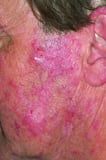 (lupus), and giant cell arteritis Giant Cell Arteritis Giant prison cell arteritis is chronic inflammation of big and medium arteries of the head, neck, and upper body. Typically affected are the temporal arteries, which run through the temples and provide... read more .
(lupus), and giant cell arteritis Giant Cell Arteritis Giant prison cell arteritis is chronic inflammation of big and medium arteries of the head, neck, and upper body. Typically affected are the temporal arteries, which run through the temples and provide... read more .
Also, an isolated, short-lived (acute) fever in people with cancer or a known inflammatory disorder is most likely to have an infectious cause. In healthy people, an acute fever is unlikely to exist the start sign of a chronic illness.
Drugs sometimes crusade fever. For case, beta-lactam antibiotics (such as penicillin Penicillins Penicillins are a subclass of antibiotics called beta-lactam antibiotics (antibiotics that accept a chemical structure called a beta-lactam ring). Carbapenems, cephalosporins, and monobactams... read more ) and sulfa drugs tin trigger a fever. Drugs that can cause an extremely high temperature include certain illicit drugs (such as cocaine Cocaine Cocaine is an addictive stimulant drug made from leaves of the coca constitute. Cocaine is a strong stimulant that increases alacrity, causes euphoria, and makes people feel powerful. High doses... read more , amphetamines Amphetamines Amphetamines are stimulant drugs that are used to treat sure medical conditions, but are also field of study to abuse. Amphetamines increment alertness, heighten physical performance, and produce... read more than , or phencyclidine Ketamine and Phencyclidine (PCP) <span class="disableDrug">Ketamine</span> and phencyclidine are chemically similar drugs used for anesthesia but are sometimes used recreationally. Ketamine is available... read more ), anesthetics Anesthetics In some cases, treating the underlying disorder eliminates or minimizes the pain. For example, setting a cleaved bone in a cast or giving antibiotics for an infected joint helps reduce hurting.... read more , and antipsychotic drugs Antipsychotic drugs Schizophrenia is a mental disorder characterized by loss of contact with reality (psychosis), hallucinations (usually, hearing voices), firmly held false beliefs (delusions), abnormal thinking... read more than .
Almost all infectious disorders can cause fever. Just overall, the well-nigh likely infectious causes are
-
Upper and lower respiratory tract infections
-
Gastrointestinal infections
Almost acute respiratory tract and gastrointestinal infections are viral.
Sure conditions (adventure factors) brand people more probable to have a fever. These factors include the following:
-
The person's health status
-
The person's age
-
Certain occupations
-
Utilize of certain medical procedures and drugs
-
Exposure to infections (for example, through travel or contact with infected people, animals, or insects)
Usually, a dr. can determine that an infection is present based on a cursory history, a physical examination, and occasionally a few simple tests, such equally a chest x-ray and urine tests. Yet, sometimes the crusade of fever is not readily identified.
When doctors initially evaluate people with an acute fever, they focus on 2 general issues:
-
Identifying other symptoms such as headache or cough: These symptoms help narrow the range of possible causes.
-
Determining whether the person is seriously or chronically sick: Many of the possible astute viral infections are difficult for doctors to diagnose specifically (that is, to determine exactly which virus is causing the infection). Limiting testing to people who are seriously or chronically ill can help avoid many expensive, unnecessary, and ofttimes fruitless searches.
In people with an astute fever, sure signs and characteristics are crusade for business concern. They include
-
A change in mental role, such as confusion
-
A headache, stiff neck, or both
-
Apartment, small, purplish red spots on the skin (petechiae), which indicate bleeding under the pare
-
Depression claret force per unit area
-
Rapid heart rate or rapid breathing
-
Shortness of breath (dyspnea)
-
A temperature that is higher than 104° F (40° C) or lower than 95° F (35° C)
-
Recent travel to an surface area where a serious infectious disease such as malaria is common (endemic)
-
Recent employ of drugs that suppress the immune system (immunosuppressants)
People who take any alert signs should come across a doctor right away. Such people typically need immediate testing and oft admission to a hospital.
People without warning signs should phone call the doctor if the fever lasts more than 24 to 48 hours. Depending on the person's age, other symptoms, and known medical conditions, the doctor may ask the person to come up for evaluation or recommend treatment at home. Typically, people should meet a doctor if a fever lasts more than than 3 or four days regardless of other symptoms.
Doctors first ask questions about the person's symptoms and medical history. Doctors so exercise a physical examination. What they find during the history and physical examination often suggests a cause of the fever and the tests that may need to be done.
A md begins by asking a person almost nowadays and previous symptoms and disorders, drugs currently being taken, whatsoever blood transfusions, exposure to infections, recent travel, vaccinations, and recent hospitalizations, surgeries, or other medical procedures. The blueprint of the fever rarely helps the md brand a diagnosis. However, a fever that returns every other twenty-four hours or every third twenty-four hours is typical of malaria. Doctors consider malaria as a possible cause only if people accept traveled to an area where malaria is common.
Recent travel may give the medico clues to the cause of a fever because some infections occur only in certain areas. For case, coccidioidomycosis (a fungal infection) occurs virtually exclusively in the southwestern Us.
Contempo exposures are also important. For example, people who piece of work in a meatpacking plant are more likely to develop brucellosis (a bacterial infection spread through contact with domestic animals). Other examples include dangerous water or food (such as unpasteurized milk and milk products, and raw or undercooked meat, fish, and shellfish), insect bites (such as ticks or mosquitoes), unprotected sex, and occupational or recreational exposures (such every bit hunting, hiking, and water sports).
Pain is an important inkling to the possible source of fever, and then the doctor asks about any pain in the ears, caput, cervix, teeth, throat, chest, abdomen, flank, rectum, muscles, and joints.
Other symptoms that help determine the cause of the fever include nasal congestion and/or discharge, cough, diarrhea, and urinary symptoms (frequency, urgency, and pain while urinating). Knowing whether the person has enlarged lymph nodes or a rash (including what it looks like, where information technology is, and when it appeared in relation to other symptoms) may help the doctor pinpoint a cause. People with recurring fevers, night sweats, and weight loss may have a chronic infection such every bit tuberculosis or endocarditis (infection of the heart's lining and normally the heart valves).
The doctor may besides ask about the following:
-
Contact with anyone who has an infection
-
Any known weather that predispose to infection, such as HIV infection, diabetes, cancer, organ transplantation, sickle cell disease, or eye valve disorders, particularly if an artificial valve is nowadays
-
Whatsoever known disorders that predispose to fever without infection, such as lupus, gout, sarcoidosis, an overactive thyroid gland (hyperthyroidism), or cancer
-
Utilise of any drugs that predispose to infection, such as cancer chemotherapy drugs, corticosteroids, or other drugs that suppress the allowed system
-
Apply of illicit drugs that are injected
The physical examination begins with confirmation of fever. Fever is near accurately determined by measuring rectal temperature. Then the dr. does a thorough exam from head to toe to check for a source of infection or bear witness of affliction.
The need for testing depends on what the doc finds during the medical history and physical examination.
Otherwise healthy people who accept an acute fever and just vague, general symptoms (for example, they feel by and large ill or achy) probably have a viral disease that volition become away without treatment. Therefore, they do not require testing. Exceptions are people who have been exposed to an animal or insect that carries and transmits a specific disease (called a vector), such every bit people with a tick bite, and people who have recently been in an expanse where a item disorder (such as malaria) is mutual.
If otherwise good for you people accept findings that suggest a particular disorder, testing may be needed. Doctors select tests based on those findings. For example, if people have a headache and potent neck, a spinal tap (lumbar puncture) is washed to look for meningitis. If people have a cough and lung congestion, a chest x-ray is done to expect for pneumonia.
People who are at increased adventure of infection, people who appear seriously sick, and older people often need testing fifty-fifty when findings practise not suggest a particular disorder. For such people, doctors often exercise the following:
-
A complete blood count (including the number and proportion of unlike types of white blood cells)
-
A chest x-ray
-
Urinalysis
An increment in the white blood cell count usually indicates infection. The proportion of different types of white blood cells (differential count) gives further clues. For example, an increase in neutrophils suggests a relatively new bacterial infection. An increase in eosinophils suggests the presence of parasites, such as tapeworms or roundworms. Too, blood and other trunk fluids may be sent to the laboratory to try to grow the microorganism in a culture. Other blood tests can be used to find antibodies against specific microorganisms.
A fever of unknown origin may exist diagnosed when
-
People have a fever of at least 101° F (38.3° C) for several weeks
-
All-encompassing investigation does not detect a cause
In such cases, the cause may be an unusual chronic infection (such as tuberculosis Tuberculosis (TB) Tuberculosis is a chronic contagious infection caused by the airborne bacteria Mycobacterium tuberculosis. It usually affects the lungs. Tuberculosis is spread mainly when people breathe... read more  , bacterial infection of the center Infective Endocarditis Infective endocarditis is an infection of the lining of the heart (endocardium) and usually also of the heart valves. Infective endocarditis occurs when bacteria enter the bloodstream and travel... read more
, bacterial infection of the center Infective Endocarditis Infective endocarditis is an infection of the lining of the heart (endocardium) and usually also of the heart valves. Infective endocarditis occurs when bacteria enter the bloodstream and travel... read more 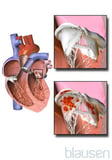 , HIV infection Man Immunodeficiency Virus (HIV) Infection Human immunodeficiency virus (HIV) infection is a viral infection that progressively destroys certain white blood cells and tin cause acquired immunodeficiency syndrome (AIDS). HIV is transmitted... read more than
, HIV infection Man Immunodeficiency Virus (HIV) Infection Human immunodeficiency virus (HIV) infection is a viral infection that progressively destroys certain white blood cells and tin cause acquired immunodeficiency syndrome (AIDS). HIV is transmitted... read more than  , cytomegalovirus Cytomegalovirus (CMV) Infection Cytomegalovirus infection is a common herpesvirus infection with a broad range of symptoms: from no symptoms to fever and fatigue (resembling infectious mononucleosis) to severe symptoms involving... read more than , or Epstein-Barr virus Infectious Mononucleosis Epstein-Barr virus causes a number of diseases, including infectious mononucleosis. The virus is spread through kissing. Symptoms vary, but the virtually mutual are extreme fatigue, fever, sore pharynx... read more
, cytomegalovirus Cytomegalovirus (CMV) Infection Cytomegalovirus infection is a common herpesvirus infection with a broad range of symptoms: from no symptoms to fever and fatigue (resembling infectious mononucleosis) to severe symptoms involving... read more than , or Epstein-Barr virus Infectious Mononucleosis Epstein-Barr virus causes a number of diseases, including infectious mononucleosis. The virus is spread through kissing. Symptoms vary, but the virtually mutual are extreme fatigue, fever, sore pharynx... read more 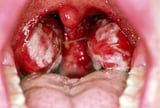 ) or something other than an infection, such as a connective tissue disorder (such every bit lupus Systemic Lupus Erythematosus (SLE) Systemic lupus erythematosus is a chronic autoimmune inflammatory connective tissue disorder that can involve joints, kidneys, skin, mucous membranes, and blood vessel walls. Problems in the... read more than
) or something other than an infection, such as a connective tissue disorder (such every bit lupus Systemic Lupus Erythematosus (SLE) Systemic lupus erythematosus is a chronic autoimmune inflammatory connective tissue disorder that can involve joints, kidneys, skin, mucous membranes, and blood vessel walls. Problems in the... read more than  or rheumatoid arthritis Rheumatoid Arthritis (RA) Rheumatoid arthritis is an inflammatory arthritis in which joints, usually including those of the easily and feet, are inflamed, resulting in swelling, pain, and often destruction of joints.... read more
or rheumatoid arthritis Rheumatoid Arthritis (RA) Rheumatoid arthritis is an inflammatory arthritis in which joints, usually including those of the easily and feet, are inflamed, resulting in swelling, pain, and often destruction of joints.... read more  ) or cancer (such as lymphoma Overview of Lymphoma Lymphomas are cancers of lymphocytes, which reside in the lymphatic arrangement and in blood-forming organs. Lymphomas are cancers of a specific type of white blood cells known as lymphocytes. These... read more than
) or cancer (such as lymphoma Overview of Lymphoma Lymphomas are cancers of lymphocytes, which reside in the lymphatic arrangement and in blood-forming organs. Lymphomas are cancers of a specific type of white blood cells known as lymphocytes. These... read more than  or leukemia Overview of Leukemia Leukemias are cancers of white blood cells or of cells that develop into white claret cells. White claret cells develop from stem cells in the bone marrow. Sometimes the development goes awry... read more than ). Other causes include drug reactions, blood clots (deep vein thrombosis Deep Vein Thrombosis (DVT) Deep vein thrombosis is the formation of claret clots (thrombi) in the deep veins, unremarkably in the legs. Blood clots may form in veins if the vein is injured, a disorder causes the blood to clot... read more than
or leukemia Overview of Leukemia Leukemias are cancers of white blood cells or of cells that develop into white claret cells. White claret cells develop from stem cells in the bone marrow. Sometimes the development goes awry... read more than ). Other causes include drug reactions, blood clots (deep vein thrombosis Deep Vein Thrombosis (DVT) Deep vein thrombosis is the formation of claret clots (thrombi) in the deep veins, unremarkably in the legs. Blood clots may form in veins if the vein is injured, a disorder causes the blood to clot... read more than  ), inflammation of organ tissues (sarcoidosis Sarcoidosis Sarcoidosis is a disease in which abnormal collections of inflammatory cells (granulomas) form in many organs of the body. Sarcoidosis normally develops in people aged 20 to xl, most often people... read more
), inflammation of organ tissues (sarcoidosis Sarcoidosis Sarcoidosis is a disease in which abnormal collections of inflammatory cells (granulomas) form in many organs of the body. Sarcoidosis normally develops in people aged 20 to xl, most often people... read more  ), and inflammatory bowel disease Overview of Inflammatory Bowel Illness (IBD) In inflammatory bowel diseases, the intestine (bowel) becomes inflamed, frequently causing recurring abdominal hurting and diarrhea. The two primary types of inflammatory bowel illness (IBD) are Crohn... read more . In older people, the most common causes of FUO are giant prison cell arteritis Giant Jail cell Arteritis Giant jail cell arteritis is chronic inflammation of big and medium arteries of the head, neck, and upper body. Typically affected are the temporal arteries, which run through the temples and provide... read more , lymphomas, abscesses, and tuberculosis Tuberculosis (TB) Tuberculosis is a chronic contagious infection caused past the airborne leaner Mycobacterium tuberculosis. It unremarkably affects the lungs. Tuberculosis is spread mainly when people breathe... read more than
), and inflammatory bowel disease Overview of Inflammatory Bowel Illness (IBD) In inflammatory bowel diseases, the intestine (bowel) becomes inflamed, frequently causing recurring abdominal hurting and diarrhea. The two primary types of inflammatory bowel illness (IBD) are Crohn... read more . In older people, the most common causes of FUO are giant prison cell arteritis Giant Jail cell Arteritis Giant jail cell arteritis is chronic inflammation of big and medium arteries of the head, neck, and upper body. Typically affected are the temporal arteries, which run through the temples and provide... read more , lymphomas, abscesses, and tuberculosis Tuberculosis (TB) Tuberculosis is a chronic contagious infection caused past the airborne leaner Mycobacterium tuberculosis. It unremarkably affects the lungs. Tuberculosis is spread mainly when people breathe... read more than  .
.
Ultrasonography Ultrasonography Ultrasonography uses loftier-frequency sound (ultrasound) waves to produce images of internal organs and other tissues. A device chosen a transducer converts electrical current into audio waves... read more than  , computed tomography (CT) Computed Tomography (CT) In computed tomography (CT), which used to be called computed axial tomography (Cat), an ten-ray source and x-ray detector rotate around a person. In modern scanners, the x-ray detector unremarkably... read more than
, computed tomography (CT) Computed Tomography (CT) In computed tomography (CT), which used to be called computed axial tomography (Cat), an ten-ray source and x-ray detector rotate around a person. In modern scanners, the x-ray detector unremarkably... read more than 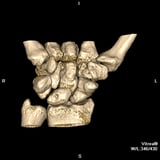 , or magnetic resonance imaging (MRI) Magnetic Resonance Imaging (MRI) In magnetic resonance imaging (MRI), a strong magnetic field and very high frequency radio waves are used to produce highly detailed images. MRI does not utilise 10-rays and is usually very rubber... read more
, or magnetic resonance imaging (MRI) Magnetic Resonance Imaging (MRI) In magnetic resonance imaging (MRI), a strong magnetic field and very high frequency radio waves are used to produce highly detailed images. MRI does not utilise 10-rays and is usually very rubber... read more 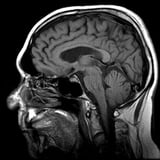 , peculiarly of areas that are causing discomfort, may help a doctor diagnose the cause. Radionuclide scanning Radionuclide Scanning In radionuclide scanning, radionuclides are used to produce images. A radionuclide is a radioactive form of an element, which means it is an unstable atom that becomes more stable by releasing... read more , done later on white blood cells labeled with a radioactive mark are injected into a vein, may be used to place areas of infection or inflammation.
, peculiarly of areas that are causing discomfort, may help a doctor diagnose the cause. Radionuclide scanning Radionuclide Scanning In radionuclide scanning, radionuclides are used to produce images. A radionuclide is a radioactive form of an element, which means it is an unstable atom that becomes more stable by releasing... read more , done later on white blood cells labeled with a radioactive mark are injected into a vein, may be used to place areas of infection or inflammation.
If these exam results are negative, doctors may need to have a sample of tissue from the liver, bone marrow, or some other site of suspected infection for biopsy. The sample is then examined nether a microscope, cultured, and analyzed.
Because fever helps the body defend against infection and because fever itself is not unsafe (unless it is higher than most 106° F [41.i° C]), there is some debate as to whether fever should be routinely treated. Even so, people with a loftier fever generally experience much ameliorate when the fever is treated. Plus, people with a heart or lung disorder and those with dementia are considered to be at particular risk of unsafe complications, then when they have a fever, it should be treated.
Drugs used to lower body temperature are chosen antipyretics.
The most constructive and widely used antipyretics are acetaminophen and nonsteroidal anti-inflammatory drugs (NSAIDs), such as aspirin, ibuprofen, and naproxen.
Typically, people may take i of the following:
-
650 milligrams of acetaminophen every 6 hours (non to exceed 4,000 milligrams in 1 day)
-
200 to 400 milligrams of ibuprofen every 6 hours
Because many over-the-counter cold or influenza preparations contain acetaminophen, people must be careful non to take acetaminophen and 1 or more of these preparations at the same fourth dimension.
Other cooling measures (such equally cooling with a tepid h2o mist and using cooling blankets) are needed simply if the temperature is about 106° F (41.1° C) or college. Sponging with alcohol is avoided considering alcohol can be absorbed through the skin and may have harmful furnishings.
People who have a blood infection or who have abnormal vital signs (such as low blood force per unit area and a rapid pulse and animate charge per unit) are admitted to the hospital.
Fever can be tricky in older people considering the trunk may non respond the fashion it would in younger people. For example, in delicate older people, infection is less probable to cause fever. Even when elevated by infection, the temperature may be lower than the standard definition of fever, and the degree of fever may not correspond to the severity of the illness. Similarly, other symptoms, such equally pain, may be less noticeable. Frequently, a change in mental function or a decline in daily functioning is the only other initial sign of pneumonia Infirmary-Caused Pneumonia Hospital-acquired pneumonia is lung infection that develops in people who have been hospitalized, typically after nigh 2 days or more than of hospitalization. Many bacteria, viruses, and even fungi... read more or a urinary tract infection Overview of Urinary Tract Infections (UTIs) In healthy people, urine in the bladder is sterile—no bacteria or other infectious organisms are present. The tube that carries urine from the bladder out of the body (urethra) contains no bacteria... read more .
-
Most fevers in healthy people are caused by a respiratory or gastrointestinal infection due to a virus.
-
Doctors can usually place an infection based on a brief medical history, a physical examination, and occasionally a few uncomplicated tests, and then doctors use these results, particularly symptoms, to determine which other tests are needed.
-
Doctors consider underlying chronic disorders, particularly those that impair the immune organisation, every bit a possible cause of fever that lasts a long time.
-
Taking acetaminophen or an NSAID normally lowers fever and usually makes people experience better, although for most people, treatment is non crucial.
-
In older people, infections are less likely to cause fever, and other symptoms may exist less noticeable.
Source: https://www.msdmanuals.com/home/infections/biology-of-infectious-disease/fever-in-adults
0 Response to "Adult Almost Done With Antibiotics and Running Fever Again"
Publicar un comentario